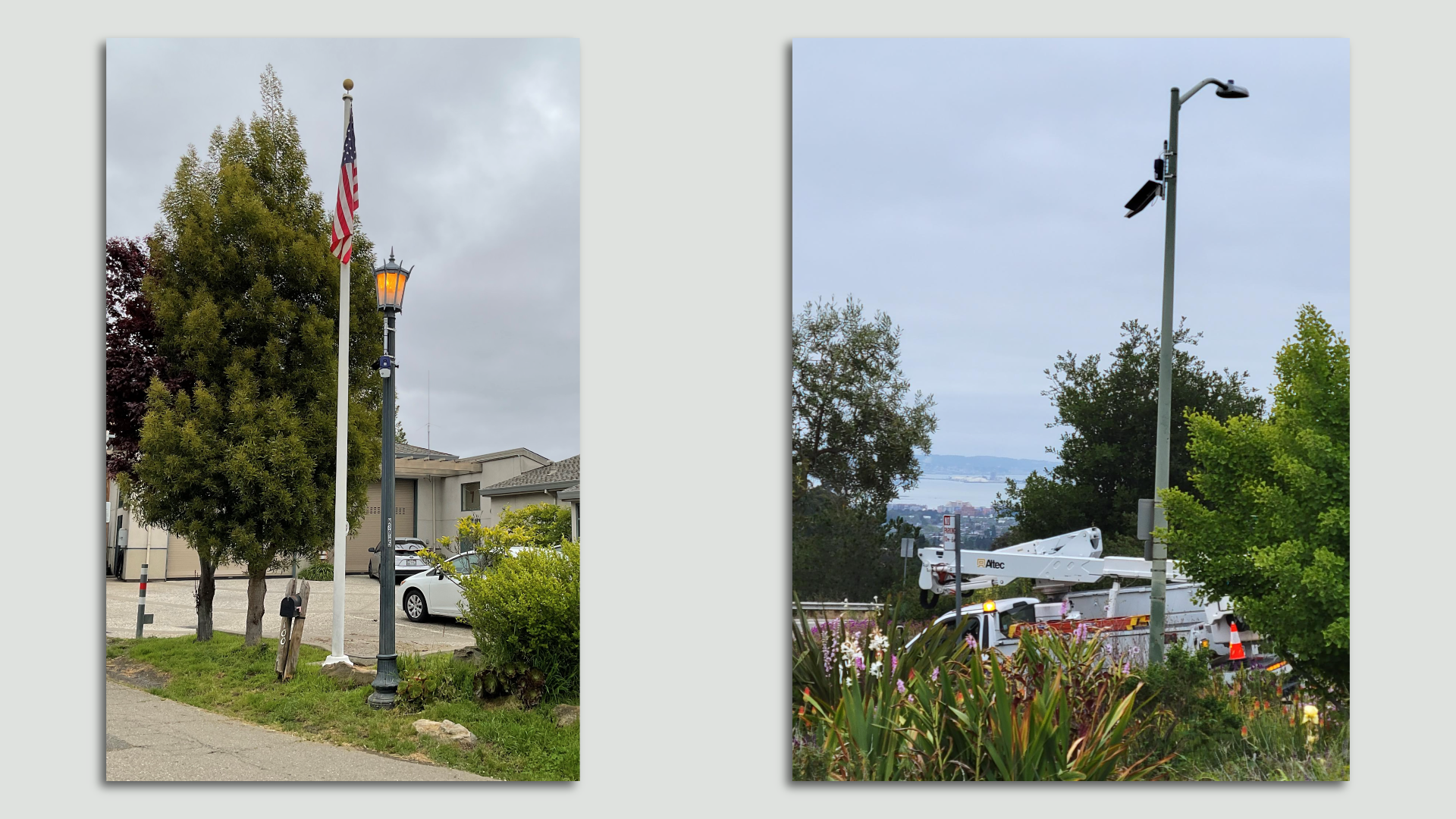Small, low-cost sensors — about the size of a lunchbox and hung on light poles and elsewhere — are being tested in wildfire-prone communities as a potential new early warning tool.
- The sensors "smell" the chemical components of a fire before it ignites, which drones, satellites and other visual surveillance safeguards cannot.
Driving the news: The U.S. Department of Homeland Security (DHS) has deployed several hundred fire sensors in a handful of willing places — most recently Oakland, California — where urban homes bump up against wilderness.
- The sensors continuously transmit olfactory information, and send an alert when they smell something wrong.
- "We're looking at volatile organic compounds and gases," says Jeff Booth, who leads the Sensors and Platforms Technology Center at the DHS' Science and Technology Directorate. "So, carbon dioxide and nitrous oxide, sulfur dioxides, particulate matter."
- While the field tests are in their infancy, "so far, the technology looks promising," Booth tells Axios.
Where it stands: Sensors from two vendors are being tested both in controlled burns and live deployments in Virginia, Oregon, Washington, California and Canada (though sensors in Quebec weren't in place early enough to prove their mettle against the current fires there).
- Oakland installed 10 sensors in May and plans to test them for two years.
- Santa Clara County in California has just signed up with N5 Sensors — one of the DHS vendors — to deploy them as well.
- One goal of the program is to test the sensors in all weather conditions in strategic locations throughout the wildland-urban interface, or WUI (endearingly pronounced "wooey").
What they're saying: The sensors "are literally 1,000 times more sensitive than the smoke detector you have in your house right now," Booth tells Axios.
- They're also "extremely different than typical sensors," which are optical and usually deployed on a fire tower, aircraft or satellite.
- While those are useful, Booth says, "you're looking at a fire by this point. We're trying to get to the ignition point."
Case study: In Gilpin County, Colorado, just west of Denver, the local fire department tested N5's sensors during a wintertime prescribed burn.
- When an unanticipated flareup occurred overnight, the sensors detected the problem and notified the fire department — "37 minutes before the first 911 call," Booth said.
- A similar situation occurred in Canada, before the point of actual ignition.
- "If we can get notifications to authorities in as small and tight a time frame as possible, then we can hopefully prevent some future catastrophic fires," Booth said.
How it works: N5's system uses a network of fixed sensors that can sit on a utility pole or a traffic light and "look for the earliest signature of fire," says Abhishek Motayed, CEO of N5 Sensors.
- Upon detection, the sensor sends an email or text notification to a pre-programmed contact.
- "These systems are non-camera-based and can work in any condition, like a rainstorm, or in times when you have smoke from the fire blocking the visibility of cameras," Motayed tells Axios.
- The sensors look for an array of chemicals, smoke and particulate in the air, and other conditions. "We combine all of that to make the accurate prediction of fire," Motayed said.
From there, "we go one step beyond," gathering data from multiple sensors to track how a fire may be moving, he added.
- "In the future, we can provide chemical hazard detection capability," Motayed said. "If there's a chemical spill, you can detect where the spill is progressing."
- Customers include utility companies, local governments, farmers and ranchers — even wineries, since fire and smoke can destroy grape harvests.
- The sensors themselves cost $2,000-$2,500, but customers must also pay for ongoing monitoring.
Yes, but: Disadvantages include a high rate of false alarms — which is frustrating for fire departments. (DHS says it's working on this.)
- There's also the "crippling challenge of needing human power or elaborate methods like autonomous helicopters for initial deployment," per an academic review published last year in the journal Sustainability.
- "This challenge can quickly devolve into an insurmountable hurdle when the target terrain is remote, vast and hostile."
The other side: "Oakland, on their red alert days, they want to know every warning — they want to be notified," Booth says. "Because they actually shut down permits for camping and campfires and what have you, right?"
The big picture: "Fire weather" conditions are growing more common across the U.S., at the same time that Canada's unprecedented wildfires are blowing foul air across the upper Midwest — and continuing to plague New York, Washington, D.C., and beyond.
- 60,000 wildfires a year break out across the U.S., burning millions of acres, per DHS.
- "Fire season is like rush hour — it doesn't exist any longer. It's just continuous," says Booth.

Backstory: DHS, in collaboration with the Federal Emergency Management Agency, undertook the fire sensor project after a successful five-year effort to test and deploy flood sensors, many of them in Texas.
What's next: Fire and flood sensors may one day work in concert with your car's navigation system to alert you to hazards while you're driving, as DHS and FEMA demonstrated this week.
- And commercial applications may be ample. "Fast-forward say, 10 years," Booth said. "If we were able to miniaturize these — which we can do — and put it in your doorbell and your home security camera, perhaps your insurance company would give you a discount."
- Or the tech could be built into a wristwatch, so that "a human becomes a mobile sensor."
- "If we had that network, how much better would we be prepared to identify these potential fires?" Booth said.







